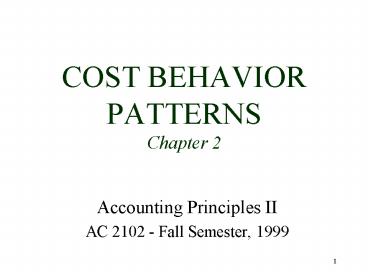COST BEHAVIOR PATTERNS Chapter 2
1 / 9
Title:
COST BEHAVIOR PATTERNS Chapter 2
Description:
Step-Variable Costs. Costs that follow a step-cost behavior with narrow steps ... Step-Fixed Costs. Costs that follow a step-cost behavior with wide steps ... –
Number of Views:489
Avg rating:3.0/5.0
Title: COST BEHAVIOR PATTERNS Chapter 2
1
COST BEHAVIOR PATTERNSChapter 2
- Accounting Principles II
- AC 2102 - Fall Semester, 1999
2
Basic Cost Behavior Patterns
- Variable Costs
- Fixed Costs
- Mixed Costs
3
Variable Costs
- Variable costs move in total in direct proportion
to the change in activity output - Thus for a variable cost, a linear relationship
between the activity cost and the associated
driver is assumed - Thus, the increase in the total variable cost
the increase in the associated driver is
assumed the same - Formula TVC 50 x No. of Units of Driver
- Important to determine the relevant range
- relevant range is the range over which the
assumed cost relationship is valid
4
Fixed Cost
- A cost which remains constant over the relevant
range - It is a cost which whose magnitude is unaffected
by changes in the level of activity - Formula TFC 80,000
- It should be noted that fixed cost per unit
varies with changes in the level of activity,
while the variable costs per unit do not change
as the activity level changes
5
Step-Cost Behavior
- A step cost has the property of displaying a
constant level of cost for a range of activity
usage (output) and then jumping to a higher level
of cost at some point - Step-Variable Costs
- Costs that follow a step-cost behavior with
narrow steps - Usually approximated with a strictly variable
cost assumption - Step-Fixed Costs
- Costs that follow a step-cost behavior with wide
steps before a jump to a higher level
6
The Need For Cost Separation
- Generally, the only information the accounting
system provides is the total cost of an activity
and a measure of activity usage - Example for maintenance accounting data is
generated which indicates the total cost of
maintenance and the number of maintenance hours
worked. But the system does not reveal the
amount of the cost that was variable and the
amount that was fixed. - It is therefore necessary to separate the total
costs into its fixed and variable components - There are various methods for doing this,
including the high-low method, the scatterplot
method, and the method of least squares - They will not be covered in this course
7
Additional Cost Classifications
- Controllable vs. Uncontrollable
- Historical vs. Future
- Differential or Incremental
- Opportunity and Imputed
8
(No Transcript)
9
(No Transcript)































